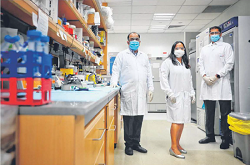
Photo credit: The Straits Times (c) Singapore Press Holdings, Jason Quah
Pictured: Members of the team involved in the gastric cancer research include (from far left) Duke-NUS Medical School research fellow Vikrant Kumar and senior research associate Kalpana Ramnarayanan, as well as Dr Raghav Sundar, a consultant at the National University Cancer Institute, Singapore
16 November 2021 - To have a more sophisticated understanding of gastric cancer, scientists here haved created an intricate atlas of the cancer cells to offer more insight into how they can spread within the body.
The map goes into granular detail on how specific molecular pathways can drive cancer growth, while also providing insight on how the disease can be better treated, said Dr Raghav Sundar, a consultant at the Department of Haematology-Oncology at the National University Cancer Institute, SIngapore.
"For example, using Singapore as an analogy, the cancer cell wants to go from home to the airport. We know that it could take these major expressways, and we have drugs to block these roads. But using our analysis, we are able to identify that the cancer cells also can take other small roads to get to their destination," said Dr Sundar.
In a similar vein, while gastric cancer is caused by changes in the genes of epithelial cells that line the surface of the stomach, it is important to think about all the other interactions between the cancer cells and their surrounding cells that help to proliferate cancer growth, he added.
For instance, some types of gastric tumours were found to contain immune cells - particularly B-cells, which control the generation of antibodies.
"We found a specific interaction between the cancer cell and the B-cell, which prevents these B-cells from doing their job to attack the cancer cell," Dr Sundar said.
The research was led by Duke-NUS Medical School and the Agency for Science, Technology and Research's Genome Insitute of Singapore (GIS), and involved collaborators from the National University Health System, among other institutions.
It was published in the Cancer Discovery scientific journal on Oct 7.
The study was part of work done by the Singapore Gastric Cancer Consortium, a national body of clinicians and scientists conducing research work on the cancer. It is supported by the National Medical Research Council.
From 2018 to last year, tumour samples were taken from 31 patients, who were being treated at the National University Hospital, at various stages of their disease.
From these samples, the scientists analysed a total of 200,000 separate cells and discovered more than 30 different cell types involved in gastric cancer, some of which have never beden detected in the cancer before.
Professor Patrick Tan of Duke-NUS' Cancer and Stem Cell Biology Programme and GIS, who was principal investigator of thne study, said one example wsould be the role of fibroblasts - cells that are important for wound healing - in driving gastric cancer.
"Fibroblast cells are hijacked by the cancer cells to provide an optimal supporting environment for tumour sustenance and tumour cell migration and spread," he said.
"While a role for fibroblasts in gastric cancer has been suggested by previous studies, it was not known how many different sub-population of fibroblasts there are, and which are directly involved in supporting tumour growth," he added.
The study revealed four different types of fibroblasts, of which one particular type may be the most important for driving gastric cancer, he added.
Dr Sundar noted that these cells tended to be higher in numbers in late-stage cancers.
Prof Tan said the study reinforces the fact that every tumour is unique - just like every patient - explaining that this is why similar teatments can yield very different outcomes in patients.
"One day, tumours may be routinely profiled at the single-cell level to provide a better understanding of the composition of the cancer, and guide clinicians on the sort of treatment for their patients," he added.
Source: The Straits Times (c) Singapore Press Holdings